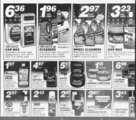Pages | 7 of 41
Hill Air Force Base Newspapers | 1991-06-28 | Page 7
| Type | issue |
| Date | 1991-06-28 |
| Paper | Hill Air Force Base Newspapers |
| Language | eng |
| City | Clearfield |
| County | Davis |
| Category | Military |
| Rights | No Copyright - United States (NoC-US) |
| Publisher | Digitized by J. Willard Marriott Library, University of Utah |
| ARK | ark:/87278/s6tf45g9 |
| Reference URL | https://newspapers.lib.utah.edu/ark:/87278/s6tf45g9 |
Page Metadata
| Type | page |
| Date | 1991-06-28 |
| Paper | Hill Air Force Base Newspapers |
| Language | eng |
| City | Clearfield |
| County | Davis |
| Category | Military |
| Page | 7 |
| Reference URL | https://newspapers.lib.utah.edu/ark:/87278/s6tf45g9/23433182 |











































